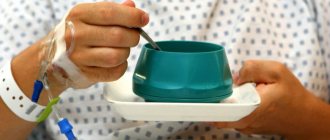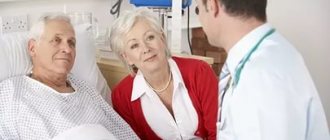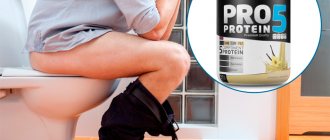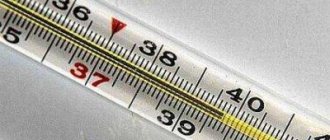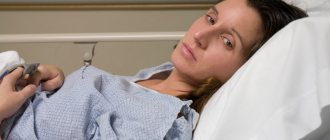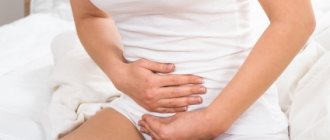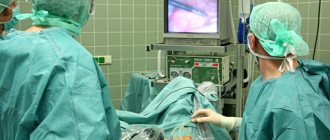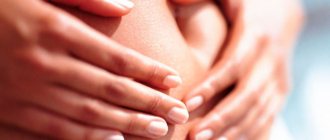Appendicitis is a disease of the appendix of the cecum. The pathology is inflammatory in nature. Sometimes this disease causes diarrhea, which is often associated with severe pain in the lower abdomen on the right side. The patient has pale skin and a fever.
Diarrhea can often be a consequence of surgery, an allergic reaction to medications, or pathologies of the intestinal microflora. Often, diarrhea can disappear on its own after surgery, but if it appears due to surgery or as a consequence of antibiotic therapy, it will be necessary to take probiotics.
Information about appendicitis
Inflamed appendix
The main problem is that a person, noticing diarrhea and pain in the abdomen, does not immediately go to the hospital. Patients think that these symptoms are caused by the fact that they ate something wrong the day before, so the symptoms will go away on their own. However, the problem we are considering will by no means go away spontaneously.
If you ignore appendicitis, it will cause a rupture of the appendix, due to which the person may well die. If you suspect this problem, you should immediately visit a medical specialist who will refer you for surgery to remove the appendix. Modern technologies allow intervention to be carried out quickly and without dire consequences.
Let's try to find out what symptoms you should pay special attention to, how to understand your condition in a timely manner so that you can immediately go to the hospital.
What is appendicitis? This is an inflammation of the appendix, a branch of the human cecum. Evolutionarily, it turned out that this organ has become almost a rudiment, in other words, our body can function quite well without it. Some time ago, experts even put forward the theory that the appendix should be disposed of in childhood, until the organ suffers from inflammation. But they decided to abandon this idea, because such a radical intervention in childhood can provoke health problems.
Diarrhea and fever
If the postoperative period is accompanied by diarrhea and fever in the first days, this indicates the body’s response to surgery.
Hyperthermia appears during healing of the wound surface, installation of drainage, and normalizes on its own after eliminating the causes.
Fever and diarrhea accompany the patient before and after surgery with purulent appendicitis and inflamed intestines. In this case, antibiotics are prescribed. Painful signs arise as a response of immune cells to anesthetics that cause intoxication of the body.
Various types of infections enter the body during surgery if the sterility of the surgical field is not achieved or the intestines are not cleaned well enough. Inflammation and suppuration of the wound begins. The doctor prescribes a comprehensive examination to determine the type of complication. Treatment is reviewed, and in some cases, repeat surgery is required.
Weakened immune defense increases the risk of contracting infectious diseases accompanied by diarrhea and fever.
The causes of complications are caused by:
- hospital infection;
- doctors' mistakes;
- unhealthy diet;
- exacerbation of concomitant diseases due to weakened immune defense;
- traumatic operation;
- suture defects, drainage;
- inadequate postoperative therapy.
The duration of the temperature is influenced by the method of surgical intervention. With a classic incision, the wound takes longer to heal than punctures during laparoscopy; therefore, painful symptoms last for a longer period.
Causes of diarrhea with appendicitis
Diarrhea quite rarely accompanies the disease we are considering, so the diagnosis is often made incorrectly. Inflammation of the appendix may also be accompanied by constipation or rare loose stools about two times, often before persistent manifestations typical of appendicitis occur. Diarrhea in the acute period of illness is:
- response to inflammation and irritation of the abdominal cavity;
- the result of problems with fluid absorption in the intestine;
- the occurrence of infectious processes;
- deviations in the natural environment of the intestine;
- exacerbation of chronic diseases due to a decline in immunity due to appendicitis.
Operation
The operation itself to remove the appendix is not a complex surgical procedure.
It lasts within half an hour and is carried out in two ways: classical, with an incision in the abdominal cavity, or laparoscopic, by removing the appendix through punctures.
However, in case of complications (for example, peritonitis, which we have already discussed), it is also necessary to do complex drainage of the abdominal cavity, followed by special tubes being brought out for lavage in the postoperative period.
The danger of appendicitis and its complications
This disease threatens with possible complications, and more specifically, their consequences. Most of them can even harm your health more than appendicitis itself. So for the success of treatment and reducing the risk of death, you need to visit a medical specialist in time, who will carry out the necessary diagnostic measures.
Peritonitis as a complication of appendicitis
The most common complications of this disease:
- Peritonitis occurs when the appendix bursts due to perforation or rupture of the wall of the organ, resulting in pus flowing into the peritoneum. The inflammation spreads, causing purulent abscesses. This condition leads to blood poisoning and death. Usually the problem extends to the abdominal region and certain areas of the intestines. It is possible to assume that a patient has developed peritonitis when he complains of severe pain, dry mouth and fever. Since injured areas of the intestine must be removed during surgery, such an intervention is considered more serious than removing the appendix. Subsequently, the patient suffers from intestinal adhesions and intestinal obstruction.
- Appendiceal infiltration is a serious problem that provokes chronic appendicitis. A dense pathological formation appears near the affected organ. This is the body's protective reaction to the formation of something foreign inside. It is very difficult to get rid of the complication.
- Pylephlebitis is the most dangerous complication, in which the disease actively attacks the main vessels of the liver, which become inflamed, resulting in problems with blood supply. This causes death.
Data regarding the number of deaths from this disease vary, the number of deaths increases when the situation is critical, if a person in need of urgent care is admitted to a medical facility with advanced appendicitis in the late stages with complex peritonitis or pylephlebitis.
Please note: if you think you have appendicitis, go to a medical facility immediately. This simple measure will allow you to save your own life. Until a specialist examines you, do not place a heating pad on the sore spot, do not take painkillers or other medications.
Diagnostics
Important! Statistics report that 1 in 5 cases of appendicitis is misdiagnosed. However, in most cases, inflammation is found in 15-40% of patients with an “acute abdomen”.
Anorexia, nausea, pain in the right lower quadrant of the abdomen and vomiting occur only in 50% of cases of inflammation. Nausea is present in 61-92% of patients. Anorexia occurs in 74-78%. When vomiting occurs, it almost always follows the onset of pain. Vomiting that precedes pain indicates intestinal obstruction. In this case, the diagnosis of appendicitis should be reconsidered. Loose stools or constipation are observed in 18% of patients and do not always indicate appendicitis.
Diarrhea
The most common symptom of appendicitis is abdominal pain. Typically, symptoms begin as periumbial or epigastric pain migrating to the right lower quadrant of the abdomen. This migration of pain is the most distinctive feature of appendicitis. Patients typically lie down, flex their hips, and elevate their knees to reduce movement and avoid increased pain. The patient later describes worsening progressive pain, vomiting, nausea, and anorexia. There is usually no fever (high body temperature) at this stage. The color of the stool also looks normal.
The duration of symptoms is less than 48 hours in approximately 80% of adults, but tends to be prolonged in older adults and patients with intestinal perforation. Approximately 2% of patients report pain lasting more than 2 weeks.
A thorough examination (blood test, stool test) should normally be performed in any patient with suspected inflammation of the appendage. It is necessary to study the gastrointestinal (GI), genitourinary and pulmonary systems. In addition, a rectal examination is required in any patient with an unclear clinical picture, and a pelvic examination is required in all women with abdominalgia.
Abdominalgia
How to identify the disease
Alas, no one can be saved from the disease we are considering. It affects both children and adults of any gender. In older people, appendicitis occurs less frequently, since over time the lumen of the appendage becomes overgrown. Diarrhea with this disease does not always occur; it is not a distinctive feature of appendicitis, so it is necessary to judge the problem by several manifestations at once.
The main manifestations of appendicitis are as follows:
- not too much pain in the area around the navel. Over time, the pain becomes stronger and moves to the right hypochondrium. If inflammation occurs too quickly, gangrene can occur and the appendix dies. When the pain suddenly stops bothering you, there is a high probability that the organ has ruptured and pus has leaked into the peritoneum;
- intoxication with products of the inflammatory process of the appendix provokes a characteristic clinical picture - nausea and vomiting. Diarrhea often occurs for this reason. Mucus and blood may be found in the stool;
- Diarrhea may occur if the appendix is located in the loop-shaped bends of the colon. Inflammatory processes are transferred to the cecum, as a result of which the liquid is not absorbed as efficiently. The food comes out half-digested, the feces are not formed;
- very often diarrhea is characteristic of appendicitis in three-year-old children;
- vomiting, nausea and diarrhea go along with appetite disturbances (doctors may assume that the person has inflammation of the appendix);
- body temperature does not rise above 38 degrees. If it grows very quickly, the process of life-threatening purulent peritonitis may have begun;
- a white coating appears on the tongue (the person also complains of dry mouth).
Only a medical specialist can make an accurate diagnosis by palpating the abdomen, examining the tongue, measuring pressure and temperature.
It is important to call emergency services quickly because every minute matters. You must tell the dispatcher as accurately as possible about your condition. Hold back your emotions, as this prevents you from speaking normally about the problem. If first aid is provided in a timely manner, a person’s health will quickly return to normal.
It is very important to distinguish appendicitis from other diseases, for example, Crohn's disease, inflammation of the ovaries in women, torsion of the testicle or strangulated inguinal hernia in men. It is also necessary to separate inflammation of the appendix from gastroenteritis and poisoning.
Characteristic symptoms of appendicitis
Depending on the stage of development, appendicitis is accompanied by a different clinical picture. At the first (catarrhal) stage there are no signs of the disease. The second (superficial) stage is accompanied by severe pain in the area where the appendix is located: on the right side of the lower abdomen.
At the third (phlegmonous) stage, the inflammatory process involves all layers of the appendix. The patient develops diarrhea or constipation, nausea and vomiting, and an increase in body temperature. The fourth (ulcerative) stage is accompanied by the formation of ulcers on the intestinal walls, and there is a risk of rupture of the caecum.
Gangrenous (fifth) stage of appendicitis is diagnosed extremely rarely and is characterized by rupture of appendix tissue and discharge of purulent contents into the abdominal cavity. Due to the development of medical technologies, the disease is recognized at stages 2-3, which allows timely assistance to the patient.
Appendicitis is also accompanied by pale skin, chills and the formation of a white coating on the tongue.
Manifestations of the disease in childhood
Appendicitis threatens the life of an infant more than an adult, since it is very difficult to identify this problem in children. In addition, this disease in children is characterized by rapid development, increasing the possibility of suffering from peritonitis.
In infants, the disease we are considering is diagnosed very rarely. Most often the problem occurs after 2-3 years. Most cases of appendicitis are found in adolescents aged 15 to 19 years.
The main manifestations of the disease occur immediately after the onset of the pathological process. This is diarrhea and vomiting caused by problems with intestinal activity. This condition is accompanied by acute pain throughout the entire plane of the abdomen. The pain gets worse after 12-24 hours.
If the appendix is located unusually, the baby may feel pain in the back and rectum. When the organ is in the pelvis, the child suffers from frequent urination, which provokes severe abdominal pain.
Children under three years of age cannot specifically localize the pain caused by appendicitis. The development of inflammation can be assumed based on the following signs:
- the baby is capricious more often than usual;
- the child refuses to eat, has vomiting and diarrhea;
- there is evidence of poisoning;
- if you try to touch the stomach, the baby starts crying, preventing you from doing this.
At-Home Treatment Options
Here are a few things you can do at home to relieve diarrhea symptoms:
- Drink plenty of fluids (water, juices or broths).
- Choose foods that are easier to digest, such as rice and mashed potatoes.
- Avoid foods high in fiber, fat, or dairy. Also try to stay away from sour, spicy or very sweet foods.
- Avoid drinks that contain alcohol and caffeine.
- Relax in a warm bath to relieve abdominal or rectal discomfort.
- Try taking probiotics to boost the levels of beneficial bacteria in your digestive tract.
- Use over-the-counter medications with caution. In some cases, medications such as bismuth subsalicylate or loperamide may help relieve symptoms. However, if an infection is causing your symptoms, these types of medications will not help and may be potentially dangerous.
If diarrhea lasts more than two days or you have a child whose diarrhea lasts more than 24 hours, get medical help right away.
How the disease develops in stages
Stages of development of appendicitis without the necessary treatment
The first stage is called catarrhal appendicitis. Often this period lasts several hours, the inflammatory processes do not extend beyond the mucous membranes.
The second stage is superficial. Inflammatory processes develop, so the mucous membranes are injured. The patient notes severe pain. At this time, if you look into the lumen of the appendix, you can see blood.
The next stage is called phlegmonous. At this time, the disease spreads to all layers of the appendix, affecting its outer shells.
The next stage is phlegmonous-ulcerative. During this process, ulcers form on the mucous membrane of the organ, which is a signal that the immune system can no longer fight inflammatory processes. The situation is becoming increasingly dangerous.
The final stage is called gangrenous. At this time, the appendix completely dies, after which it usually ruptures. The pus and blood that were inside it pour into the abdominal cavity. The result is the occurrence of peritonitis, and then death. Alas, even if by this moment the person is in the hospital, they are unlikely to be able to help him. It is not advisable for the situation to come to this.
Appendicitis often develops within a couple of days. In other words, the disease is considered fleeting. When symptoms arise that suggest appendicitis, it is advisable to play it safe and see a doctor. The sooner the diagnosis is made, the greater the chances of a favorable outcome of the situation. It is advisable to seek help in the first two stages. When the third stage starts, the risk of dying becomes higher every minute.
Why does diarrhea occur after surgery?
Like most visits to the doctor, wisdom tooth removal begins with an examination. Whether it hurts or not, the dentist will take an x-ray to find out what is happening with your wisdom teeth, namely, how they are located and whether there is enough space for them to grow.
If you experience discomfort or your dentist anticipates problems with your wisdom teeth, you will be given a date to have them removed. The operation will be performed either by your attending physician or a dental surgeon.
Luckily, wisdom teeth removal is not a Saw horror movie. The procedure is performed under local anesthesia (you are awake and can feel pressure, but do not feel pain); general anesthesia or anesthesia (you don’t feel anything).
The type of pain relief depends on how difficult the dentist considers the procedure to be, as well as your general condition and level of anxiety. You will be asked to refrain from eating and drinking until the procedure, depending on the type of anesthesia.
The dentist will also recommend that you drink plenty of water, but will not allow you to use a straw for two weeks. Using a straw can cause dry socket, an incredibly painful condition in which the clot above the extraction site is dislodged, exposing bone and nerves.
Brushing too vigorously after surgery can also be harmful, so be sure to ask your doctor about how soon you can return to normal oral hygiene based on your specific situation.
If you develop a dry socket, your dentist will place a medicated paste on the tooth to help the wound heal. Dry socket is the most common complication after tooth extraction, so it is important that you follow all instructions after surgery.
Treatment of various diseases through surgery occurs when medications do not help and their further use is inappropriate. Most often, diarrhea appears in the postoperative period during the removal of sections of the gastrointestinal tract, gallbladder, and cholecystectomy treatment.
Such operations can provoke the appearance of secondary factors that can cause harmful bacteria introduced during surgery by medical personnel.
If diarrhea after surgery on the gastrointestinal tract lasts no more than three days, and does not cause much concern, this is considered normal. If streaks of blood appear in the stool, and diarrhea itself continues to bother you for longer than is considered normal, the patient should immediately seek help from a doctor to find out the cause of the symptom.
Specifics of diarrhea in the disease
Diarrhea may be characteristic of the first stage of inflammation, when symptoms have not yet manifested themselves. It also happens in the next two stages, when the tissues of the appendix suffer from inflammation.
Options for appendicitis location
Appendicitis with a typical location of the appendix
If the location of the appendix is not unusual, then inflammation can be detected by characteristic pain, lack of appetite, nausea, single diarrhea or vomiting. In general, the person feels satisfactory, the body temperature is low. As the inflammatory processes progress, nausea and pain become stronger, the temperature rises, but there is no diarrhea.
Retrocecal appendicitis
This type of disease is distinguished by the atypical location of the process. It may be located behind the cecum, close to the kidneys or the muscles of the belt.
In such a situation, the pain seems to move. Nausea or vomiting does not occur as often. The specificity of this type of disease is that the stool is more like mush, since the appendix irritates the cecum. This type of disease, together with diarrhea, can cause problems with urination.
Pelvic appendicitis
With this type of disease, the appendix is located in the pelvis. Since the organ is located atypically, the symptoms are very clear. The pain spreads throughout the abdominal cavity and pelvis, urination becomes more frequent. As for stool, it is liquid, repeated, and resembles gruel (or watery in structure). There may be clots and streaks of blood or mucus in the stool.
This type of disease is specific to women, and doctors often confuse this type of appendicitis with other diseases. It is very important to conduct a differentiated diagnosis, separating appendicitis from problems with the urinary system and intestines.
Prevention
After surgery, the following preventive recommendations will help improve the patient’s condition:
- refusal to eat solid foods;
- exclusion of preservatives;
- eating boiled rice, mashed potatoes, broths;
- exclusion of fatty meats in favor of dietary types (turkey, chicken);
- when introducing fermented milk products, give preference to low-fat ones;
- sufficient fluid intake;
- bed rest.
Diarrhea with appendicitis is usually quite rare. Severe diarrhea may indicate an abnormal location of the cecum. After surgery, diarrhea can be the result of dysbacteriosis, allergies to medications, or a consequence of taking antibiotics. For treatment, probiotics, sorbents, rehydration solutions, enzymes and drugs to slow down intestinal motility are prescribed. Diet plays an important role in the prevention and treatment of diarrhea after appendicitis.
Throughout life, a person faces many different diseases of the gastrointestinal tract. Sometimes diarrhea is a symptom of one of them - appendicitis.
Modern medicine has made great progress, so appendectomy is a fairly simple procedure, but diarrhea often becomes a complication after it.
Important! When the first symptoms of exacerbation or disruption of the abdominal organs appear, you must immediately seek qualified help. If diarrhea occurs after appendectomy, be sure to tell your doctor about the previous procedure.
Specifics of diarrhea after illness
Diarrhea after surgery after removal of the appendix while following a developed diet is not considered something strange - it is caused by the consumption of large volumes of liquid food. The patient does not suffer from discomfort, the number of trips to the toilet does not exceed five times a day, the temperature is normal, there is no nausea or vomiting.
When loose stools continue for more than three days, this indicates serious problems. Be sure to tell your doctor about your condition.
Allergic reaction to drugs
Often, before the operation, the patient is asked whether he has an individual intolerance to certain medications. If there is one, then in the patient’s chart they write about atopic dermatitis, bronchial asthma and other manifestations of allergic reactions.
It is worth saying that diarrhea after surgery can be triggered by a specific immune sensitivity to the drugs used for pain relief before surgery or used after surgery to restore the body and protect it from infections.
Allergic reactions to drugs can manifest as diarrhea after removal of the appendix, the inflammation of which caused nausea and vomiting, severe pain and bloating. Clots of mucus and blood can be seen in the stool.
Allergies can also cause rhinitis, cough, swelling of the mucous membranes of the nose and oropharynx, rash on the skin and mucous membranes, itching, fever, aches and pain in the muscles.
Dysbacteriosis
Main symptoms of dysbiosis
This intestinal problem may occur due to changes in the balance of the natural intestinal microflora due to the development of pathogenic microorganisms and a decrease in the number of beneficial lactobacilli.
The named disease after a successful operation can be characterized by diarrhea or constipation, which, by the way, can replace each other. Distinctive features of feces:
- feces have a sour or rotten odor;
- stool color – yellow, green or yellow-green;
- The consistency of the stool is mush, there are mucous inclusions.
In addition, a person may experience nausea, lack of appetite, bloating and heartburn.
Diarrhea caused by antibiotics
This problem is typical for surgical removal of the appendix, when the patient is forced to take antibiotics (or are given them intravenously). These drugs prevent both harmful and beneficial bacteria from working. An imbalance in the microflora of the digestive system appears.
Antibiotic-associated diarrhea is a type of intestinal dysbiosis. It occurs in the form of diarrhea with blood and mucus admixture. Typically a person goes to the toilet up to 30 times a day. Along with diarrhea, a person suffers from bloating, intestinal pain, nausea, vomiting, weakness and fever.
Such frequent bowel movements provoke dehydration. This condition, of course, becomes life-threatening for the patient.
Diarrhea after IVs
Diarrhea that occurs after IV drips is caused by intolerance to the agents used for administration. During recovery after the intervention, antibacterial drugs are injected into a person's vein to stop and prevent inflammation from developing. These agents, penetrating into the body, kill not only pathological microorganisms, but also prevent lactobacilli from acting. And this causes internal imbalances and diarrhea.
After surgery, rehydration solutions are also introduced into the body to help compensate for the lack of water and electrolytes. An increased dose of the drug causes the volume of permissible fluid in the body to exceed, and this in turn provokes diarrhea.
Diarrhea after anesthesia
Diarrhea can also occur after anesthesia, which is caused by individual intolerance to drugs used for pain relief for the period after surgery. In this case, diarrhea is a consequence of an allergic reaction.
Diarrhea and vomiting after anesthesia after appendix removal can signal the development of inflammation in the peritoneum. This may also be a consequence of stress suffered due to radical intervention.
Medicines
The goal of rehabilitation is to restore intestinal motility. The absorption and assimilation of nutrients from food depends on its work, and therefore the time when the body gets stronger.
Taking medications is a way to treat diarrhea
When treating diarrhea with medications, the following are prescribed:
- Probiotics to restore intestinal microflora.
- Antidiarrheal drugs that regulate peristalsis.
- Saline solutions that replenish fluids and maintain electrolyte balance.
- Enterosorbents for removing toxins.
If diarrhea is caused by an infection, then antimicrobial drugs are prescribed. Among them:
- antifungal agents;
- antiseptics;
- fluoroquinolones.
The choice of a specific remedy depends on the patient’s clinical picture and the type of infection: intestinal, respiratory tract or skin.
Treatment
If diarrhea signals the acute phase of appendicitis, no measure can be effective or justified. The person needs immediate hospitalization in a medical facility. Treatment should be prescribed based on the patient's condition. Diarrhea itself, no matter whether it is frequent or episodic, is not considered a disease. Pay attention exclusively to inflammation of the appendix.
The use of medications is recommended in extremely rare situations, because the catarrhal type of appendicitis is very rare. A person usually comes to a medical facility with developed inflammation, even peritonitis. There is only one way out - urgent surgery to remove the appendix. Medicines are used as a supplement to relieve pain and avoid blood poisoning.
If we talk about diarrhea after surgery, then the treatment measures and the need for it are directly related to the reasons for the development of the problem. When loose stools after cutting out the appendix are caused by the specifics of a temporarily followed diet, you need to wait for the return to your usual diet. Medicines are most often not required; on the contrary, it is advisable to avoid stress on the body.
If diarrhea after surgery is caused by pathological processes, you should think about an integrated approach. For convenience, let’s look at the features of therapy, collected in the table:
It is highly not recommended to use medications like Loperamide or Imodium for diarrhea after surgery.
Diet
After surgery to remove your appendix, you will need to follow a special diet to protect yourself from diarrhea. Doctors advise adhering to the following rules:
- eat 5-6 times a day: portions should be small, food should be warm, but not hot;
- during the first two days after the intervention, the menu should include chicken and vegetable broths, mineral water, rosehip decoction and apple compote;
- on the third day after the intervention, chicken broth soup with potatoes, rice, pumpkin, carrots and zucchini is added to the diet;
- a week after the operation, add “slimy” porridges made with water or diluted milk, boiled vegetables, baked apples and pears, low-fat kefir and cottage cheese.
Preventive measures against diarrhea
It is not difficult to avoid diarrhea after appendicitis removal if you follow simple rules and recommendations. The first thing to remember is that after the operation it is forbidden to take any food or drink for 10–12 hours. A small part of the intestine was damaged when the appendix was removed, so it needs to be allowed to partially recover.
During the first days after surgery, you should only eat food that is easily digested and absorbed by the body. The menu should include:
- mashed potatoes;
- cereal porridge (it is recommended to use brown unpolished rice for its preparation, which thickens stool and prevents the development of diarrhea);
- broths based on lean meat;
- vegetable stew;
- kefir with a minimum percentage of fat content;
- compotes based on fruits and berries;
- boiled dietary meat (be sure to chop before eating);
- bananas;
- baked apples.
It is forbidden to eat fresh fruits or berries, greens - they provoke stool upset. They must undergo heat treatment. Avoid sugar, salt and spices. When preparing food, make sure that the dishes do not contain vegetables that cause increased gas formation (legumes, beans, cabbage, peas).
A prerequisite is to drink plenty of warm boiled water. You can supplement it with liquid tea or herbal decoctions, but only with the permission of a doctor or after studying the contraindications - not all herbal drinks have a beneficial effect on the body, weakened by surgical intervention.
Take food in small portions, not exceeding 150–200 grams. Eat 5–7 times a day, each time washing down your meal with plenty of drink (compote of dried apples or rose hips). Make sure that the dishes are warm (45–50 degrees).
